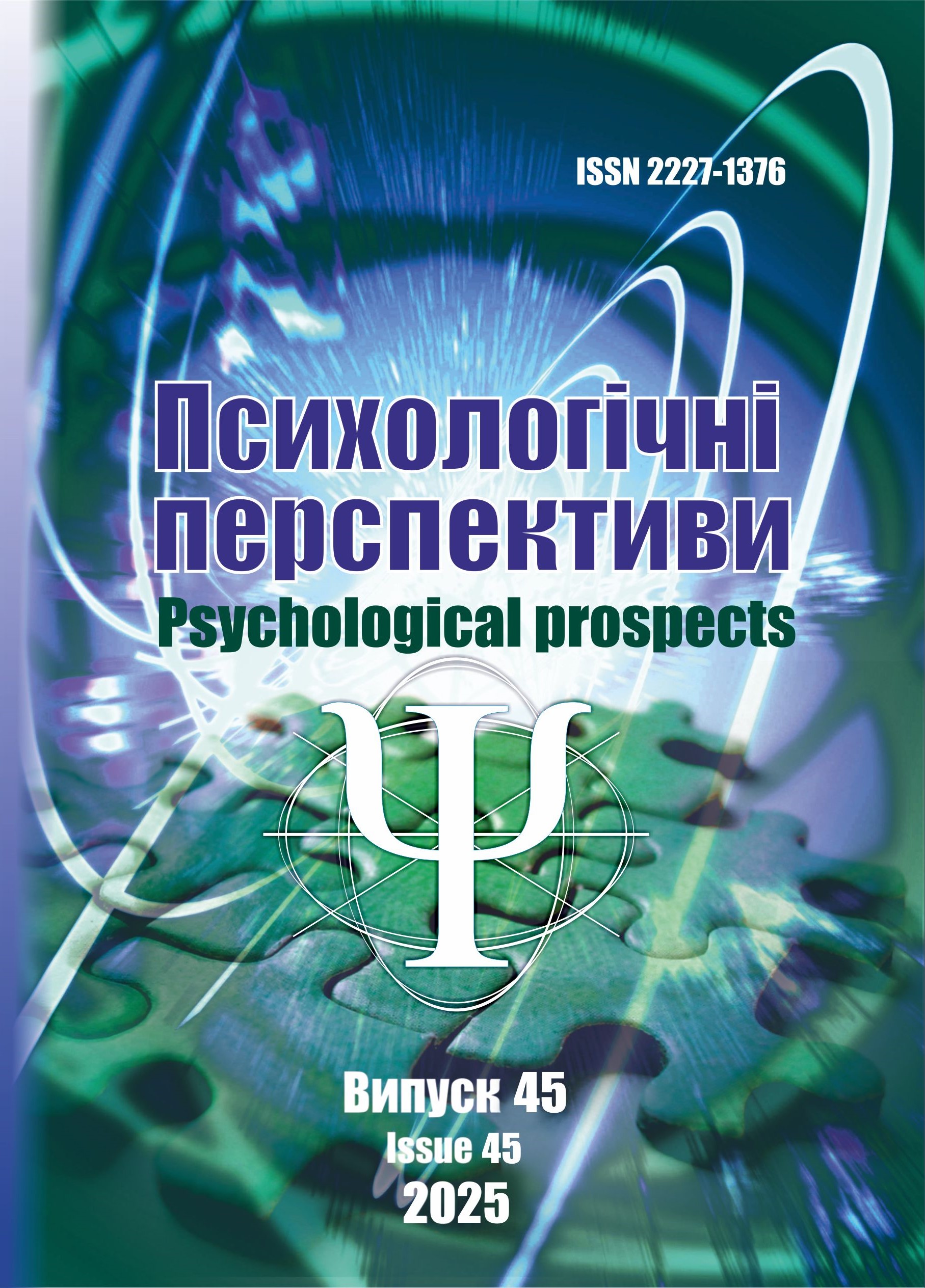ОСОБЛИВОСТІ ПРОЯВУ ТРИВАЛОГО ТРАВМАТИЧНОГО СТРЕСУ У ПІДЛІТКІВ ПІД ЧАС ВІЙНИ
DOI:
https://doi.org/10.29038/2227-1376-2025-45-solКлючові слова:
тривалий травматичний стрес, підлітки, депресія, тривожність, якість снуАнотація
Мета. Метою дослідження є вивчення психологічних особливостей переживання травматичного досвіду війни підлітками, зокрема симптомів тривалого травматичного стресу (ТТС), посттравматичного стресового розладу (ПТСР), депресії, тривожності, самотності та розладів сну.
Методи. У дослідженні взяли участь 485 підлітків віком 12–18 років. Було використано стандартизовані психодіагностичні методики: The Continuous Traumatic Stress Response scale (CTSR), the Child PTSD Symptom Scale for DSM-5 (CPSS-5), the Patient Health Questionnaire (PHQ-9) for depression, the Generalized Anxiety Disorder scale (GAD-7), the Pittsburgh Sleep Quality Index (PSQI), the UCLA Loneliness Scale. Статистична обробка включала описову статистику, кореляційний та регресійний аналіз з допомогою програмного забезпечення SPSS v.24.0).
Результати. Встановлено, що підлітки в умовах війни демонструють значну психоемоційну вразливість. 25.6% респондентів мали клінічно значущі ознаки депресії, 20.8% — тривожності, 28.2% — симптоми ПТСР, а 43.9% — порушення сну. Кореляційний аналіз виявив тісні зв’язки ТТС із депресією (r = 0.85), тривожністю (r = 0.79), ПТСР (r = 0.78) та якістю сну (r = 0.56). Результати лінійної регресії показали, що значущими незалежними предикторами ТТС є депресія, ПТСР і тривожність. Самотність та якість сну не є значущими предикторами у регресійній моделі, яка у сукупності усіх вище зазначених залежних змінних, показує високий рівень значущості (р < 0.001).
Висновки. Підлітки, що проживають в умовах війни, зазнають комплексного негативного психоемоційного впливу. Депресивна та тривожна симптоматика, а також ПТСР є ключовими предикторами ТТС. Отримані результати вказують на необхідність цілеспрямованих програм психосоціальної підтримки, орієнтованих на профілактику хронічного стресу та стабілізацію емоційного стану підлітків у кризових умовах війни.
Посилання
1. Bayer C. P., Klasen F., Adam H. (2007). Association of trauma and PTSD symptoms with openness to reconciliation and feelings of revenge among former Ugandan and Congolese child soldiers. The Journal of the American Medical Association, 298, 555-559. https://doi.org/10.1001/jama.298.5.555. DOI: https://doi.org/10.1001/jama.298.5.555
2. Eagle, G., & Kaminer, D. (2013). Continuous traumatic stress: Expanding the lexicon of traumatic stress. Peace and Conflict: Journal of Peace Psychology, 19(2), 85. https://doi.org/10.1037/a0032485 DOI: https://doi.org/10.1037/a0032485
3. Foa, E. B., Asnaani, A., Zang, Y., Capaldi, S., & Yeh, R. (2017). Psychometrics of the Child PTSD Symptom Scale for DSM-5 for Trauma-Exposed Children and Adolescents. Journal of Clinical Child & Adolescent Psychology, 47(1), 38–46. https://doi.org/10.1080/15374416.2017.1350962 DOI: https://doi.org/10.1080/15374416.2017.1350962
4. Goral A, Feder-Bubis P, Lahad M. et al. (2021) Development and validation of the Continuous Traumatic Stress Response scale (CTSR) among adults exposed to ongoing security threats. PLoS ONE. 16(5). https://doi.org/10.1371/journal.pone.0251724. DOI: https://doi.org/10.1371/journal.pone.0251724
5. Gušić, S., Malešević, A., Cardeña, E., Bengtsson, H., & Søndergaard, H. P. (2018). “I feel like I do not exist:” A study of dissociative experiences among war-traumatized refugee youth. Psychological Trauma: Theory, Research, Practice, and Policy, 10(5), 542. https://doi.org/10.1037/tra0000348. DOI: https://doi.org/10.1037/tra0000348
6. Joshi, P. T., & O'donnell, D. A. (2003). Consequences of child exposure to war and terrorism. Clinical child and family psychology review, 6, 275-292 DOI: https://doi.org/10.1023/B:CCFP.0000006294.88201.68
7. Kira, I. A., Ashby, J. S., Lewandowski, L., Alawneh, A. W. N., Mohanesh, J., & Odenat, L. (2013). Advances in continuous traumatic stress theory: Traumatogenic dynamics and consequences of intergroup conflict: The Palestinian adolescents case. Psychology, 4(04), 396. http://dx.doi.org/10.4236/psych.2013.44057. DOI: https://doi.org/10.4236/psych.2013.44057
8. Kroenke K, Spitzer RL, Williams JB. The PHQ-9: validity of a brief depression severity measure. J Gen Intern Med. 2001 Sep;16(9):606-13. https://doi.org/10.1046/j.1525-1497.2001.016009606.x. DOI: https://doi.org/10.1046/j.1525-1497.2001.016009606.x
9. Mollica, R. F., Poole, C., Son, L., Murray, C. C., & Tor, S. (1997). Effects of war trauma on Cambodian refugee adolescents' functional health and mental health status. Journal of the American Academy of Child & Adolescent Psychiatry, 36(8), 1098-1106. https://doi.org/10.1097/00004583-199708000-00017. DOI: https://doi.org/10.1097/00004583-199708000-00017
10. Okello, J., De Schryver, M., Musisi, S., Broekaert, E., & Derluyn, I. (2014). Differential roles of childhood adversities and stressful war experiences in the development of mental health symptoms in post-war adolescents in northern Uganda. BMC psychiatry, 14, 1-8. https://doi.org/10.1186/s12888-014-0260-5. DOI: https://doi.org/10.1186/s12888-014-0260-5
11. Pat-Horenczyk, R., & Schiff, M. (2019). Continuous traumatic stress and the life cycle: Exposure to repeated political violence in Israel. Current Psychiatry Reports, 21, 1-9. https://doi.org/10.1007/s11920-019-1060-x. DOI: https://doi.org/10.1007/s11920-019-1060-x
12. Sfeir, E., Geara, C., Hallit, S., & Obeid, S. (2020). Alexithymia, aggressive behavior and depression among Lebanese adolescents: A cross-sectional study. Child and adolescent psychiatry and mental health, 14, 1-7. https://doi.org/10.1186/s13034-020-00338-2. DOI: https://doi.org/10.1186/s13034-020-00338-2
13. Solomon Z., Lavi T. (2005). Israeli youth in the second intifada: PTSD and future orientation. Journal of the American Academy of Child & Adolescent Psychiatry, 44, 1167-1175. https://doi.org/10.1097/01.chi.0000161650.97643.e1. DOI: https://doi.org/10.1097/01.chi.0000161650.97643.e1
14. Sourander, A., Silwal, S., Osokina, O., Hinkka-Yli-Salomäki, S., Hodes, M., & Skokauskas, N. (2024). Suicidality and self-harm behavior of adolescents during the early phase of the war in Ukraine. Journal of the American Academy of Child & Adolescent Psychiatry, 63(12), 1204-1214. https://doi.org/10.1016/j.jaac.2024.03.015. DOI: https://doi.org/10.1016/j.jaac.2024.03.015
15. Suliman, S., Mkabile, S. G., Fincham, D. S., Ahmed, R., Stein, D. J., & Seedat, S. (2009). Cumulative effect of multiple trauma on symptoms of posttraumatic stress disorder, anxiety, and depression in adolescents. Comprehensive psychiatry, 50(2), 121-127. https://doi.org/10.1016/j.comppsych.2008.06.006. DOI: https://doi.org/10.1016/j.comppsych.2008.06.006
16. Zasiekina, L., & Martyniuk, A. (2025). War-related continuous traumatic stress as a potential mediator of associations between moral distress and professional quality of life in nurses: a cross-sectional study in Ukraine. BMC nursing, 24(1), 16. https://doi.org/10.1186/s12912-024-02668-4 DOI: https://doi.org/10.1186/s12912-024-02668-4
17. Zasiekina, L., Goral, A., Fedotova, T., Akimova, A., & Martyniuk, A. (2024). Cross-cultural adaptation and psychometric validation of The Continuous Traumatic Stress Response Scale: Ukrainian version. East European Journal of Psycholinguistics, 11(1), 156. https://doi.org/10.29038/eejpl.2024.11.1.zas DOI: https://doi.org/10.29038/eejpl.2024.11.1.zas
Завантаження
Опубліковано
Номер
Розділ
Ліцензія
Авторське право (c) 2025 Солоненко Олена

Ця робота ліцензується відповідно до ліцензії Creative Commons Attribution-NonCommercial 4.0 International License.






